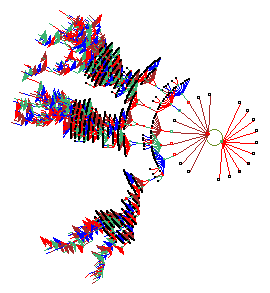

Discrete Dynamics Lab
Update Sept 1997 -
version 21
- new features
Some of the new features added since the last release in March 96 are
listed below. An updated manual covering all DDLab functions, with examples
and illustrations, is in the process of being written.
- Increased neighbourhood range, k.
Maximum k has been increased to 13 (from 9). In 2d, k=13
gives a diamond shaped neighbourhood. k can vary from 1-13 and effective
k=0 can also be set.
- The k mix.
For networks with mixed k, the proportion of different k
can be specified, then set at random.
- Sequential updating.
Updating can be sequential as well as parallel. The sequence order
can be left to right, right to left, random, or set to some particular
order. The order sequence can be saved to a file. The neutral order components
in the space of all possible orders can be calculated, and presented graphically
as quasi sub-trees. Sequential updating applies to both attractor basins
and space-time patters. Space-time patterns can be toggled on the fly between
parallel and sequential.
- Hypercube.
The network wiring can be set to correspond to a n-dimensional
hypercube if
k=log2(n), or log2(n)+1
to allow for self wiring. The connections in the hypercube can be set
according to a given probability.
- Canalizing.
New options are provided for setting canalizing inputs, C, including
different C for subsets of nodes with different k. The graphics
for depicting canalization is extended to show the frequency of different
degrees of canalization across the network.
- Derrida plot.
Options for the Derrida plot are extended to restrict the max Hamming
distance, i.e. to zoom into the lower left hand corner of the graph.
- Probabilistic networks
For forward dynamics only, the value of a network element can update
according to its rule with a given probability, equivalent to adding noise
to the system.
- Samples of rule-space sorted according to rule class.
Files are included with large samples of k=5, 6 and 7 rules
that have been sorted according to the standard deviation of input entropy.
A scatter plot of density against standard deviation discriminates between
ordered, complex and chaotic rules, where complex rules feature large scale
interacting structures such as gliders and domain boundaries. The dynamics
of particular rules in the sample can be examined, for example by selecting
from the plot with the mouse. New samples can be assembled and sorted automatically,
thus providing an unlimited source of complex rules for further study.
- Data on attractors for large networks.
For networks that are too large to generate attractor basins, data
can be gathered by generating a histogram of the frequency of reaching
different attractors, giving the number and relative size of basins, attractor
length and average run in length.
- Data on "skeletons" for large networks.
A skeleton in a RBN is a subset of network elements that has "frozen"
or stabilized along a transient before reaching the attractor, according
to some set criteria. Other elements in the network may still be changing.
A histogram of the frequency of reaching different skeletons may be generated,
giving the number and relative importance of skeletons, and average run
in length.
- Mutation
The mutation of successive of networks when drawing attractor basins
can now be turned off.
- Rotating attractor basins and changing the default "fan"
angle.
The orientation of attractor basins or sub-trees can be altered, i.e. they
may be rotated by some angle. The pre-image "fan" angle may be
changed relative to the default. Both of these adjustments can be preset,
or made during a repositioning "pause" between each successive
basin.
Return to the
Discrete Dynamics Lab home page.


